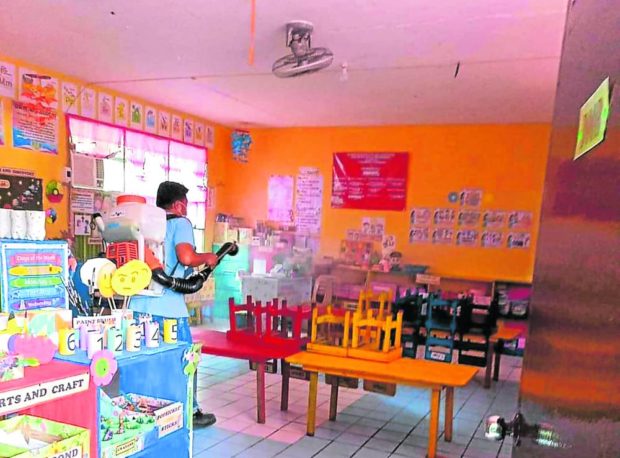
DISINFECTION DRIVE Workers from the sanitary services of the Albay Provincial Health Office conduct disinfection of classrooms in Albay Central School in Legazpi City on Nov. 18 and Nov. 24 after health authorities recorded over 500 suspected cases of hand, foot and mouth disease (HFMD) among school children in the province. PHOTO COURTESY OF THE ALBAY PROVINCIAL HEALTH OFFICE
LEGAZPI CITY—Health authorities have recorded over 500 suspected cases of hand, foot and mouth disease (HFMD) in 10 towns and two cities in the province of Albay, they said in a report on Saturday.
Based on the report from the Provincial Epidemiology Surveillance Unit, most of the 541 patients who showed symptoms of the viral disease were children age 1 to 10 years old.
The report said the suspected HFMD incidents were recorded just in 10 days, from Nov. 15 to Nov. 25, with the town Oas topping the list with 162 cases; followed by Legazpi City, 79; and Guinobatan, 73.
Probable HFMD cases were also noted in Tabaco City (25) and in towns of Daraga (55), Camalig (50), Tiwi (30), Rapurapu (13), Manito (12), Malilipot (10), Polangui and Sto. Domingo (16 cases each).
There were no confirmed cases of the disease yet, since laboratory tests were yet to be done as of Sunday.
Stay home
Disinfection were executed by sanitary services of the provincial health office (PHO) in infected areas, particularly in schools, to curtail the spread of HFMD.
Those infected were told to stay home and were allowed to attend their classes online.
William Sabater, sanitary officer of the Albay PHO, also advised the public to stay home in case they experience the symptoms associated with the disease like fever and rashes.
“HFMD is highly contagious. Normally experienced from three to 14 days [from exposure] depending on the resistance (immune system) of the patient,” Sabater told the Inquirer in a chat message.
He also reminded the public to practice good hygiene to stay healthy.
Vulnerable age group
HFMD is a common infectious disease that occurs most often in children, according to the World Health Organization. It is commonly spread through direct contact with secretions, such as saliva, from infected people.
Symptoms include a fever that may last from 24 to 48 hours, painful mouth sores, and rashes and blisters on the hands, feet and buttocks.
Those showing symptoms of infection are advised to stay home for around a week or until their fevers have receded and their sores are healed.